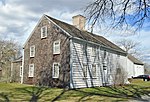William Whalley Homestead
Buildings and structures in Little Compton, Rhode IslandFederal architecture in Rhode IslandHouses in Newport County, Rhode IslandHouses on the National Register of Historic Places in Rhode IslandNational Register of Historic Places in Newport County, Rhode Island ... and 1 more
Newport County, Rhode Island Registered Historic Place stubs

The William Whalley Homestead is an historic farmstead in Little Compton, Rhode Island. The main house is a 1+1⁄2-story wood-frame structure, probably built sometime between 1815 and 1830. The property includes a late 19th century gabled barn and a stone and wood outbuilding, and is bounded by a low stone wall. The main house is a fairly typical Cape style house, five bays wide, with a central chimney. The property as a whole is a well-preserved example of a typical 19th-century farmstead in the area.The homestead was listed on the National Historic Register in 1988.
Excerpt from the Wikipedia article William Whalley Homestead (License: CC BY-SA 3.0, Authors, Images).William Whalley Homestead
Burchard Avenue,
Geographical coordinates (GPS) Address Nearby Places Show on map
Geographical coordinates (GPS)
| Latitude | Longitude |
|---|---|
| N 41.543611111111 ° | E -71.169166666667 ° |
Address
Burchard Avenue 27
02837
Rhode Island, United States
Open on Google Maps









